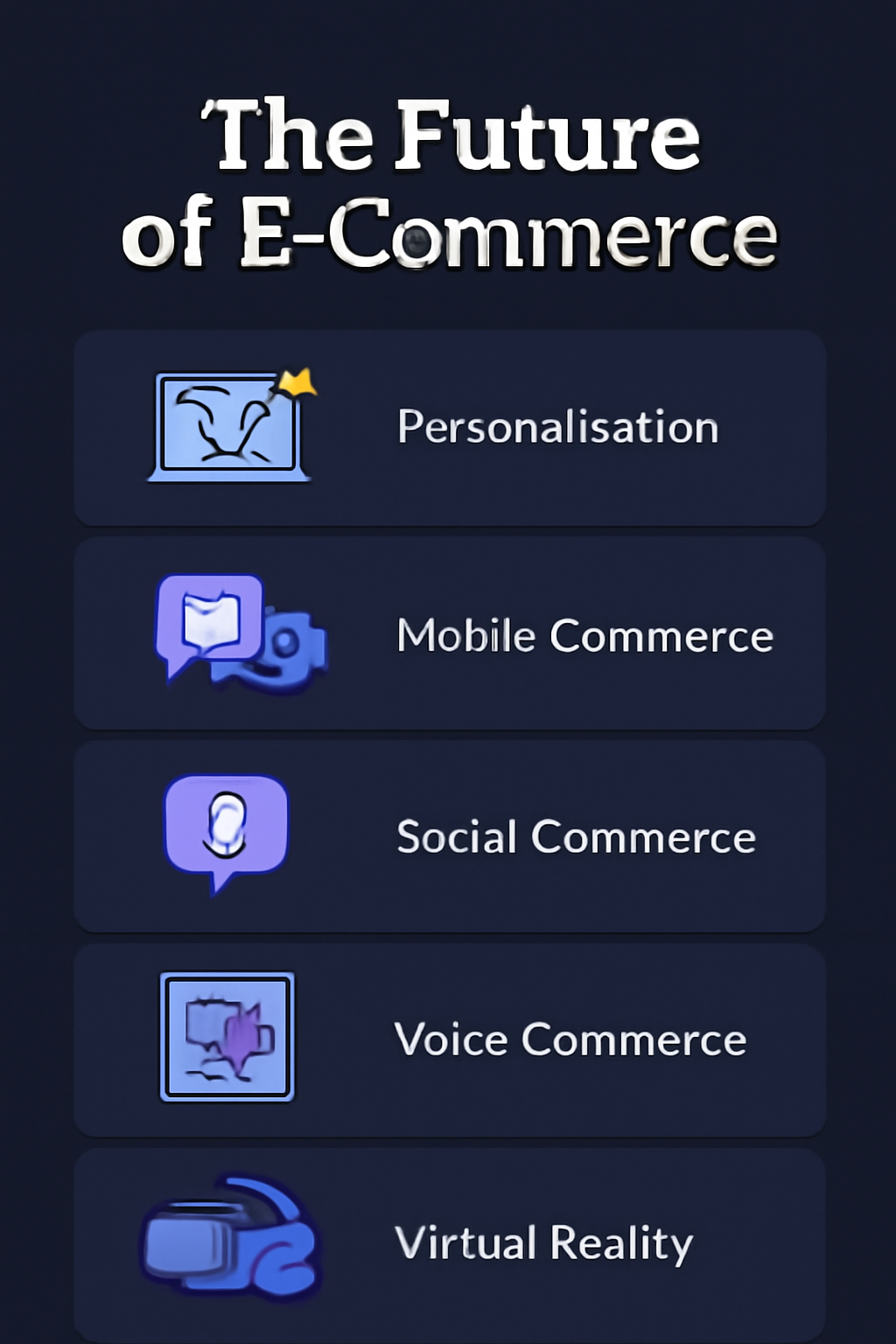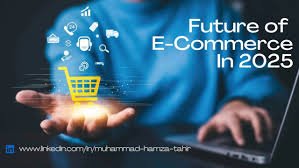The Future of E-commerce: Trends, Innovations, and How They’re Shaping Retail

Introduction
The rise of e-commerce has fundamentally transformed the way businesses operate and how consumers make purchasing decisions. With the expansion of the digital landscape, e-commerce has grown from a niche market to a global powerhouse, influencing almost every industry. From fashion and electronics to groceries and services, shopping online has become the go-to method for buying products and services. As technology continues to evolve, so does the e-commerce landscape, bringing with it exciting new trends, innovations, and challenges. This article will delve into the future of e-commerce, exploring key trends, innovations, and how businesses can stay ahead in this fast-evolving space.
The Shift Towards Personalization
In today’s e-commerce world, customers expect a highly personalized shopping experience. Personalized marketing has become an essential strategy for businesses to engage their customers. Personalized product recommendations, dynamic content, and tailored email campaigns have become common tools for brands looking to create a deeper connection with consumers.
AI-powered algorithms play a significant role in personalization. By analyzing consumer data, such as browsing behavior, purchase history, and social media activity, companies can provide more relevant product suggestions. This not only increases conversion rates but also enhances the overall shopping experience, making it easier for consumers to find products that match their preferences.
Opportunities:
-
Enhanced Customer Engagement: Personalized shopping experiences lead to higher customer satisfaction, loyalty, and repeat purchases.
-
Data-Driven Marketing: AI and data analytics help businesses target their audience with more precision, increasing the effectiveness of marketing campaigns.
Challenges:
-
Privacy Concerns: As data collection becomes more widespread, consumers are increasingly concerned about their privacy. Businesses must find a balance between personalization and protecting customer data.
-
Resource Intensity: Implementing personalization at scale requires significant investments in technology, resources, and data management.
Mobile Commerce: Shopping on the Go
Mobile commerce, or m-commerce, continues to grow at an impressive rate, reflecting the widespread adoption of smartphones and mobile devices. Today, more consumers are turning to their phones for online shopping, whether they are browsing products, reading reviews, or completing purchases. This shift toward mobile-first shopping has significant implications for businesses, as mobile commerce requires a different approach than traditional desktop-based e-commerce.
Companies must optimize their websites and apps for mobile devices, ensuring that customers have a seamless shopping experience across all platforms. From fast-loading pages and easy navigation to simplified checkout processes, mobile optimization is crucial for reducing bounce rates and boosting conversions.
Opportunities:
-
Convenience and Accessibility: Consumers can shop anytime and anywhere, making mobile commerce an appealing option for busy individuals.
-
Increased Conversion Rates: A streamlined mobile experience leads to higher conversion rates, especially as more consumers make purchases directly from their phones.
Challenges:
-
Responsive Design: Ensuring a consistent and optimized experience across various screen sizes and devices can be challenging for businesses.
-
App Development Costs: For businesses that choose to develop mobile apps, there is an added cost in terms of development, maintenance, and updates.
The Rise of Social Commerce
Social media platforms have become more than just places to connect with friends and share content—they’re now powerful e-commerce tools. Social commerce refers to the practice of selling products directly through social media platforms like Instagram, Facebook, Pinterest, and TikTok. This trend has accelerated with the rise of influencer marketing, where brands partner with social media influencers to promote their products.
The integration of shopping features on these platforms allows consumers to browse products, read reviews, and make purchases all within the app, making the shopping experience more seamless than ever. Social commerce provides businesses with an opportunity to reach a larger, more engaged audience, while also benefiting from the social proof provided by influencer recommendations.
Opportunities:
-
Targeted Advertising: Social media platforms offer sophisticated targeting options, allowing businesses to reach specific demographics based on interests, location, and behavior.
-
Engagement and Community Building: Social commerce allows brands to build a community around their products, increasing customer loyalty and brand advocacy.
Challenges:
-
Platform Dependency: Relying too heavily on third-party platforms for sales can create challenges in terms of control over customer relationships and data.
-
Authenticity Concerns: Influencer marketing can sometimes lead to skepticism if consumers feel that endorsements are inauthentic or overly commercialized.
Voice Commerce: The Next Frontier
Voice commerce, or v-commerce, refers to using voice-activated devices, such as Amazon’s Alexa, Google Assistant, and Apple’s Siri, to shop online. As voice assistants become more advanced, consumers are increasingly turning to these devices for everything from ordering groceries to buying electronics.
The convenience of voice commerce cannot be overstated—consumers can make purchases while cooking, exercising, or even driving. However, the rise of voice commerce also presents new challenges for businesses. Ensuring that their products are easily discoverable via voice search and optimizing the user experience for voice-based interactions will be crucial for staying ahead in this space.
Opportunities:
-
Hands-Free Shopping: Voice commerce offers a truly hands-free shopping experience, which appeals to time-pressed consumers.
-
Increased Sales Channels: By integrating with popular voice assistants, businesses can reach new customers and tap into the growing trend of voice-enabled technology.
Challenges:
-
Search Optimization: Voice searches often differ from text-based searches, requiring businesses to optimize their product descriptions and content for voice queries.
-
Limited Consumer Interaction: While voice commerce is convenient, it lacks the visual and tactile experience of traditional online shopping, which may limit its appeal for certain types of products.
Augmented Reality and Virtual Reality: Immersive Shopping
Augmented reality (AR) and virtual reality (VR) are two of the most exciting technologies in e-commerce, offering consumers a truly immersive shopping experience. AR allows shoppers to visualize products in their environment before making a purchase, while VR provides a fully immersive shopping experience that mimics real-world interactions.
Retailers in industries like fashion and furniture have embraced AR and VR to help customers visualize how products will look in their homes or on their bodies. For example, IKEA’s AR app lets customers see how furniture will fit into their living spaces, while makeup brands offer virtual try-ons through their apps.
Opportunities:
-
Enhanced Customer Experience: AR and VR provide a unique, interactive experience that can increase engagement and reduce return rates.
-
Differentiation: Offering AR or VR experiences can help businesses stand out from the competition by offering innovative and memorable shopping experiences.
Challenges:
-
High Implementation Costs: Developing AR and VR experiences requires a significant investment in technology, content creation, and user experience design.
-
Consumer Adoption: While AR and VR are growing in popularity, not all consumers are ready to embrace these technologies, which may limit their reach.
The Future of E-commerce: What’s Next?
As the e-commerce landscape continues to evolve, businesses will need to remain agile and adapt to changing consumer preferences and technological advancements. Some key areas to watch in the future of e-commerce include:
-
Sustainability: Consumers are becoming increasingly concerned about the environmental impact of their purchases. E-commerce businesses that prioritize sustainability, from eco-friendly packaging to ethical sourcing, will gain favor with eco-conscious shoppers.
-
AI and Automation: The integration of AI and automation will continue to drive efficiency and enhance personalization in the e-commerce space, enabling businesses to deliver better customer experiences while reducing costs.
-
Cryptocurrency Payments: As cryptocurrencies like Bitcoin and Ethereum become more mainstream, e-commerce businesses may begin to offer crypto payment options, providing greater flexibility and security for digital transactions.
Conclusion
The future of e-commerce is both exciting and full of potential. As technology continues to reshape the way businesses interact with customers, those who embrace new trends and innovations will be well-positioned for success. By focusing on personalization, mobile optimization, social commerce, voice shopping, and immersive technologies like AR and VR, e-commerce businesses can stay ahead of the curve and create memorable, impactful experiences for their customers. The possibilities are endless, and the next wave of innovation is already on the horizon.

